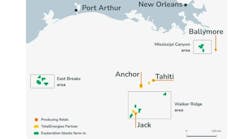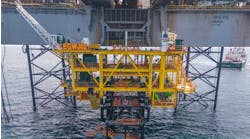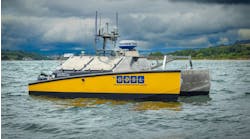Mediterranean
Apache Corp. has a fourth deepwater disc- overy in the 2.3-million-acre West Mediterr- anean Concession offshore Egypt. The El King 1X well found significant gas reserves in both the primary objective Miocene-age formation and the secondary Pliocene objective. The well also found the first Miocene deep-water oil in the Nile Delta.
Apache President and CEO G. Steven Farris said Apache is extending Egypt's prolific Nile Delta play westward, with a goal of proving up a minimum of 3 tcf in reserves on the deepwater block. "With the success in the Miocene added to a substantial 291-ft uphole column in the Pliocene, El King 1X results get us well on our way to our 3 tcf reserve goal," Farris said.
Apache had its first deepwater find in May 2002. The Abu Sir 1X well was drilled to a total depth of 7,530 ft. Abu Sir is 42 mi from shore in 3,255 ft of water, about 16 mi west of prior industry discoveries in the neighboring North Alexandria Concession. Al-Bahig, Apache's second successful well, was ann-ounced in July. Al-Bahig is 10 mi southwest of Abu Sir in 3,510 ft of water. In mid September, the El Max 1X well became Apache's third deepwater natural gas discovery in the concession. El Max 1X is in 3,100 ft of water 5.5 mi south of Abu Sir 1X.
Apache said the fifth well in the series, Abu-Sir 2X, will evaluate correlative Miocene intervals at depths approaching 11,000 ft.
Located 28.5 mi offshore in 2,361 ft of water, the El King well is 11 mi southeast of the Abu Sir 1X discovery, 8 mi southeast of Al Bahig 1X, and 4 mi east of El Max 1X.
Apache Corp. operates the concession with a 55% interest. RWE-DEA has a 35% interest, and British Petroleum holds the remaining 10%.
Middle East
In mid 3Q 2002, Qatar Petro-leum entered into a $778 million agreement with Occidental to incr-ease production from two declining fields offshore Qatar. The Idd El Shargi North Dome and Idd El Shargi South Dome reached peak production about eight years ago.
Occidental has operated the North Dome field since 1994 and the South Dome field since 1997. Plans are in place for production from North Dome to increase by 37,000 b/d.
As oil in established fields diminishes, exploration moves forward. Talisman Energy signed an exploration and production sharing agreement with the Qatar government covering offshore block 10. The block, which came available in the 2001 bidding round, covers 784,000 acres 100 km northeast of Doha between the producing Al Khaleej and Al Shaheen fields. Ratification of the agreement was scheduled to take place by 1Q 2003. Discovery potential has been estimated at 100-300 MMbbl.
The first exploration term covers five years. Talisman plans to reprocess existing 2D seismic data and to acquire new 2D and 3D surveys. The company also plans to drill three wells.
While exploration proceeds off Qatar, Oman has seen a new discovery. Lucky Goldstar International Corp. recently discovered a new offshore gas field. The field, called Tibat 1, is off the Musandam Peninsula, near the Novus Petroleum-operated Bukha gas-condensate field.
Europe
Norsk Hydro began production from the Tune field in late November 2002. The Tune development consists of a template of four wells linked via subsea installation to the Oseberg field center. Total reserves in the Tune field amount to 22.9 bcm of gas and 5.8 MMcm of condensate. Development costs for the Tune project, including the drilling of production wells, total $444 million.
The gas volumes from Tune will be used for injection in Oseberg, which will make more Oseberg gas available for export. Hydro's gas production will increase considerably from the present level of around 7 bcm/yr to 12-14 bcm/yr toward the end of the decade. Production from Tune will represent around 15% of Hydro's total gas production in 2003.
Americas
Canadian Superior is ramping up for its next exploration well offshore Nova Scotia on the company's Mariner block (EL 2409).
Acquisition of over 2,200 km of high-resolution seismic over the company's Mariner block has just been completed, according to Mike Coolen, director of East coast operations, and engineering and procurement activities are in high gear. Field work was scheduled to begin the middle of this month.
Concurrently, the company is evaluating information gained from drilling on the Marquis block, which was completed in September. A second Marquis well is being planned for midyear, the company said.
Canadian Superior is also preparing to drill on its deepwater Mayflower block, Coolen said. The Mayflower block is 285 mi straight east of Boston, Massachusetts, in close proximity to northeast United States energy markets. Drilling on the Mayflower prospect is planned for late 2003/early 2004.
While Canadian Superior lays plans, EnCana Corp. is using the Eirik Raude to drill its first operated deepwater wildcat off Nova Scotia. There is a possibility the company will drill two additional deepwater exploration wells this year.
Central Asia
Haggling continues over ownership of the Caspian Sea's resources. This time Iran is disputing Azerbaijan's claim to the Alov-Araz-Sarq oil field. Azerbaijan has halted all drilling operations by foreign companies in an attempt to prevent the conflict from escalating.
While this argument festers, another has been resolved, at least for the time being. A disagreement arose in mid November over development of the Tengiz field in the Kazakhstan sector of the Caspian Sea. At that time, TengizChevroil suspended expansion plans in the Tengiz field because of a conflict with the government of Kazakhstan over how the projects would be financed.
After a month of negotiating, a financing plan was determined and officially agreed upon. Now, the second phase of field development can continue. The primary objective of the development is to increase production from 250,000 b/d to 440,000 b/d.
TengizChevroil is owned by ChevronTexaco with 50%, KazMunaiGaz with 20%, ExxonMobil with 25%, and LUKArco with 5%.
Though one dispute has ended to the mutual satisfaction of the participants, there is little chance of resolving the recurring conflicts in the region until there is formal resolution of the international legal status of the Caspian Sea.




